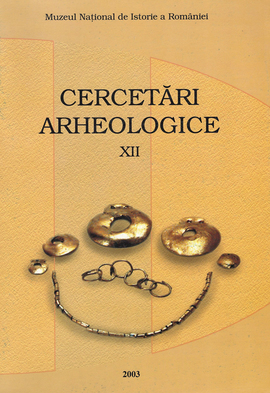Amfore de tip Käpitan II în Dacia romană
Käpitan II amphorae in Roman Dacia
Author(s): MIRCEA Negru, Alexandru Bădescu, Romeo AvramSubject(s): Archaeology
Published by: MUZEUL NAȚIONAL DE ISTORIE A ROMÂNIEI
Keywords: Roman Dacia; Käpitan II amphorae;
Summary/Abstract: Introduction The study of amphorae in Roman Dacia is still at beginning. In last decades were published some articles and studies, but most part of these are still unpublished. In this article we present only the Kapitän. II type amphorae. Typology Type A.1. Popilian IV (1) The body is shorter and more curved than usually. The rim is vertical and has a cant inside. The neck is shorter than usually. It has ears under therim level at Răcari (8), Dierna (10), Gresia (11) and Tibiscum (12). A.2. A.2.1. Brukner XV, 163:70 (nos. 2-4) The body is slight ovoid. The ears are over the level of rims. The rims are very small in diameter. The necks are cylindrical. One sample has conical hollow base. A.2.2. A.2.2.1. Kapitän II/ Zeest 79b/ Popilian 4/ Class 47/ Ostia VI/ Robinson M 237 (nos. 5-12) The body is slight ovoid and has marked shoulder. The ears are over the level of rims. The rims are vertically with oblique inside edge. The necks are slight and conical. They were dated at the end of 2nd and first half of 3rd century (5, 7, 11), first half of 3rd century AD (6), 2nd –3rd centuries AD (8), and between 240-245 AD (9), end of 3rd century AD (12), and from the end of 3rd century AD to the 4th century AD (10). A.2.2.2. Zeest 79a/Brukner XV, 163:71 (nos. 13-17) The long neck is almost cylindrical. Some of them have wall thinner than the all presented pieces (13-14, 16). They were dated at the end of 2nd century and first half of 3rd century AD (13-14), and in 2nd and 3rd centuries AD (15-17). Bases of amphorae B.1. (nos. 18-21) B.1.1. (nos. 18-19) Short curved cylindrical tubular base. Decorated with channels. They were dated at the end of 2nd century AD and first half of 3rd century AD (18) from the end of 3rd century AD to the 4th century AD (19). B.1.2. (nos. 20-21) Short cylindrical tubular base. They were dated at the end of 2nd century AD and first half of 3rd century. B.2. (nos. 22-31) B.2.1. (nos. 22-24) Cylindrical tubular base. They were dated at the end of 2nd century AD and first half of 3rd century (22), 2nd-3rd centuries AD (24), and from middle of 3rd century to beginning of 4th century AD (23). B.2.2. (nos. 25-31) Slight little truncated hollow base. They were dated at the end of 2nd century AD to the first half of 3rd century AD (25, 27-30), first half of 3rd century AD (26), end of 3rd and beginning of 4th centuries AD (31). B.3. (nos. 2, 32) Truncated tubular base. They were dated at the end of 2nd century AD and first half of 3rd century AD (32) and in the 2nd-3rd century. Conclusions Area of discoveries. Routes In Roman Dacia they were found especially in the Southern part, between the Lower Danube and Carpathians Mountains, and seldom inside or arch of Carpathians. This kind of amphorae was discovered in the archaeological sites set on the Roman roads along the Danube (at Sucidava, Orlea, Gârla Mare, Dierna), limes transalutanus (at Crâmpoia, Gresia, Jidava and Râşnov), Olt River (at Slãveni, Romula, Enoşeşti-Acidava, Stolniceni-Buridava), Jiu River (at Răcari), and Timis River (at Tibiscum). It seems that they were transported by the sea and on the Danube until the points where the Roman roads began in the north. Also, we observe that they were mostly used to supply the Roman army. Utility Most part of researchers considered that this kind of amphorae was used for transport of wine, but other ones considered as unknown contains. Chronology In the Roman camps of limes transalutanus (5-6, 9, 11, 22, 25-27), and at Romula (1, 3-4, 13, 18, 20-21, 28-32) they were dated from the end of the 2nd century AD to the first half of the 3rd century AD. At the Slăveni Roman camp, on the limes alutanus, they were found in the level dated from 205 to 251 AD. At Jidava one fragment was found into a level dated between 240-245 (9). In others Roman camps they were dated in 2nd-3rd centuries AD (2, 8, 15-16, 24). The latest discoveries are from the end of 3rd century (12), middle of 3rd century AD and beginning of 4th century AD (23), and from the 3rd-4th centuries AD (10, 19). Centers of production As a general rule, the archaeologists observed that it is most frequent in Eastern Mediterranean area and less in the Western one. In this order, they were considered that were produced around the Aegean Sea and the western part of Asia Minor.
Journal: Cercetări Arheologice
- Issue Year: XII/2003
- Issue No: 1
- Page Range: 231-240
- Page Count: 17
- Language: Romanian

